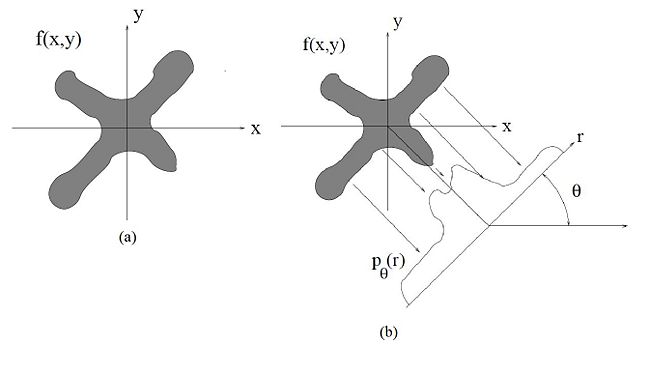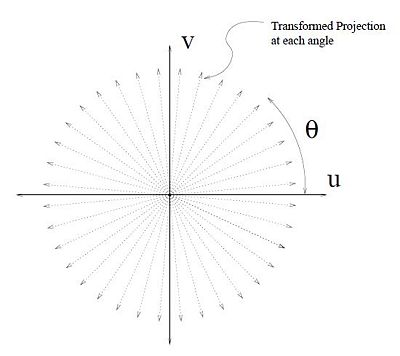Fourier Slice Theorem (FST)
A slecture by ECE student Sahil Sanghani
Partly based on the ECE 637 material of Professor Bouman.
Introduction
The Fourier Slice Theorem elucidates how the projections measured by a medical imaging device can be used to reconstruct the object being scanned. From those projections a Continuous Time Fourier Transform (CTFT) is taken. Then according to the theorem, an inverse Continuous Space Fourier Transform (CSFT) can be used to form the original object,$ f(x,y) $. There are two proofs that will be demonstrated.
Fourier Slice Theorem
Given:
$ (x,y): $= the coordinates of the system the original object resides in (as seen in Figure 1a)
$ (r,z): $= the coordinates of the system the projection resides in rotated at an angle $ \theta $ relative to the object's coordinate system (as seen in Figure 1b)
$ \rho: $= the frequency variable corresponding to $ r $
$ u: $= the frequency variable corresponding to $ x $
$ v: $= the frequency variable corresponding to $ y $
The Fourier Slice Theorem (FST) states that if
$ \begin{align} P_{\theta}({\rho}) &= CTFT \{p_\theta(r)\} \\ F(u,v) &= CSFT\{f(x,y)\} \end{align} $
Then
$ P_{\theta}({\rho}) = F(\rho\cos(\theta),\rho\sin(\theta)) \ $
This means that $ P_{\theta}({\rho}) $ is $ F(u,v) $ in polar coordinates. Basically the projection $ p_{\theta}({\rho}) $ is equivalent to the slice of $ F(u,v) $ at angle $ \theta $ that goes through the origin as seen in Figure 2.
Proof
Method 1
From the derivation of the Radon transform, we have
$ p_{\theta}(r) = \int_{-\infty}^{\infty}f(\mathbf{A_{\theta}} \begin{bmatrix} r \\ z \end{bmatrix}) dz $
Where
$ \mathbf{A_{\theta}}=\begin{bmatrix} \cos(\theta) & -\sin(\theta) \\ \sin(\theta) & \cos(\theta) \end{bmatrix} $
$ \begin{align} \Rightarrow P_{\theta}(\rho) &= CTFT \{p_\theta(r)\}\\ &= \int_{-\infty}^{\infty} p_{\theta}(r)e^{-j2\pi r\rho}dr \\ &= \int_{-\infty}^{\infty}[\int_{-\infty}^{\infty} f(\mathbf{A_{\theta}} \begin{bmatrix}r \\ z \end{bmatrix})dz]e^{-j2\pi r\rho}dr \\ &= \int_{-\infty}^{\infty} \int_{-\infty}^{\infty} f(\mathbf{A_{\theta}} \begin{bmatrix}r \\ z \end{bmatrix})e^{-j2\pi r\rho}dzdr \\ &= \int_{-\infty}^{\infty} \int_{-\infty}^{\infty} f(\mathbf{A_{\theta}}*\mathbf{A_{-\theta}} \begin{bmatrix}x \\ y \end{bmatrix})e^{-j2\pi r\rho}dzdr \ \ (*)\\ &= \int_{-\infty}^{\infty} \int_{-\infty}^{\infty} f(x,y)e^{-j2\pi r\rho} \left | \frac{\partial (r,z)}{\partial (x,y)} \right \vert dxdy \ \ (**) \\ &= \int_{-\infty}^{\infty} \int_{-\infty}^{\infty} f(x,y)e^{-j2\pi (x\rho\cos(\theta) + y\rho\sin(\theta))}dxdy \\ &= F(\rho\cos(\theta),\rho\sin(\theta)) \end{align} $
$ * $ Start a change of variable where
$ \begin{bmatrix}r \\ z\end{bmatrix} = \mathbf{A_{-\theta}} \begin{bmatrix}x \\ y\end{bmatrix} $
Note that from this relationship, $ r = x\cos(\theta) + y\sin(\theta) $ and $ z = -x\sin(\theta) + y\cos(\theta) $
$ ** $ Continue the changing of variables with the Jacobian. Note:
$ drdz = \left | \frac{\partial (r,z)}{\partial (x,y)} \right \vert dxdy $
$ \begin{align} \left | \frac{\partial (r,z)}{\partial (x,y)} \right \vert &= det \begin{bmatrix} \frac{\partial r}{\partial x} & \frac{\partial r}{\partial y} \\ \frac{\partial z}{\partial x} & \frac{\partial z}{\partial y} \end{bmatrix} \\ &= det \begin{bmatrix} \frac{\partial (x\cos(\theta)+y\sin(\theta))}{\partial x} & \frac{\partial (x\cos(\theta)+y\sin(\theta))}{\partial y} \\ \frac{\partial (-x\sin(\theta)+y\cos(\theta))}{\partial x} & \frac{\partial (-x\sin(\theta)+y\cos(\theta))}{\partial y} \end{bmatrix} \\ &= det \begin{bmatrix} \cos\theta & \sin\theta \\ -\sin\theta & \cos\theta \end{bmatrix} \\ &= \cos^2\theta + \sin^2\theta \\ &=1 \end{align} $
Method 2
Let $ \theta = 0 $. Then notice that when $ \theta = 0 $, the $ x $ and $ r $ axes line up, as do the $ y $ and $ z $ axes. From the derivation of the Radon transform, we get the following definition equation.
$ p_{\theta}(r) = \int_{-\infty}^{\infty} f(r\cos(\theta)-z\sin(\theta),r\sin(\theta)+z\cos(\theta))dz $
$ \begin{align} p_{0}(r) &= \int_{-\infty}^{\infty} f(r\cos(0)-z\sin(0),r\sin(0)+z\cos(0))dz \\ &= \int_{-\infty}^{\infty} f(r,z)dz \\ \end{align} $
Now let's take the CTFT of both sides.
$ \begin{align} P_0(\rho) &= \int_{-\infty}^{\infty} p_0(r)e^{-j2\pi r\rho}dr \\ &= \int_{-\infty}^{\infty}[\int_{-\infty}^{\infty} f(r,z)dz]e^{-j2\pi r\rho}dr \\ &= \int_{-\infty}^{\infty} \int_{-\infty}^{\infty} f(r,z)e^{-j2\pi r\rho}e^{-j2\pi z*0}drdz \\ &= \int_{-\infty}^{\infty} \int_{-\infty}^{\infty} f(x,y)e^{-j2\pi(x\rho + y0)}dxdy \\ &= F(\rho,0) \\ &= F(\rho\cos(0),\rho\sin(0)) \end{align} $
Since the FST holds true under $ \theta = 0 $, by the rotation property of the CSFT, the FST must hold true for any $ \theta $.
Remarks
Theoretically the FST is great because it shows how to take a projection and equate it to the CSFT of the scanned object. Thus in order to reconstruct the original object, all that needs to be done is an inverse CSFT.
However in practice, there are many difficulties to this approach. The measurement system (i.e. Computed Tomography) produces $ p_{\theta}({\rho}) $. From the projection, $ P_{\theta}({\rho}) $ can be calculated and then be equated to a slice of $ F(u,v) $ at a specific $ \theta $. Repeating over many $ \theta $, a set of data like that shown in Figure 2 will be obtained. All the data will be in radial lines, but the operation to reconstruct the original object (inverse CSFT) requires the data be in a rectangular grid for computation. The rectangular grid could be extrapolated and interpolated from the radial grid, but this is a source of error and lag. Those computations are intensive and are subject to data density. The farther from the origin the point to be interpolated is, the less data there is to calculate with.
Although the FST shows a convenient relationship between an object and its projections, practical implementation is unfeasible. This leads to convolution back projection, which is currently the most common reconstruction method.
References:
[1] C. A. Bouman. ECE 637. Class Lecture. Digital Image Processing I. Faculty of Electrical Engineering, Purdue University. Spring 2013.
Questions and Comments
Please post your questions and comments on the discussion page.



